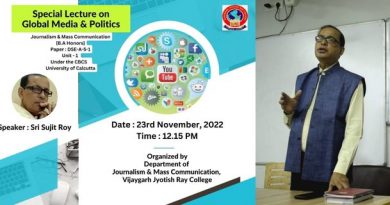Special Lecture on the Importance of HoneyBee Conservation – 26 Nov’22
Read the Reports prepared by students of Vijaygarh Jyotish Ray College based on a Special Lecture on HoneyBee Conservation in Today’s World given by Saikat Kumar Basu
Report 1
মৌমাছি সংরক্ষণ ও বর্তমান পৃথিবী
সুফল কাঞ্জিলাল, ২৭ শে নভেম্বর, কলকাতা বসন্তবায় সন্ন্যাসী হায়, চৈত-ফসলের শূন্য খেতে, মৌমাছিদের ডাক দিয়ে যায়, বিদায় নিয়ে যেতে যেতে রবি ঠাকুরের এই শেষ মধু কবিতার লাইন শোনেনি এমন মানুষ প্রায় নেই বললেই চলে। মৌমাছি পালন এবং বর্তমান পৃথিবীতে মৌমাছির বেঁচে থাকাটা ঠিক কতোটা গুরুত্বপূর্ণ বর্তমান পৃথিবীর ভারসাম্য রক্ষার ক্ষেত্রে সেই বক্তব্যের মধ্যে দিয়েই এক অনুষ্ঠানের সূচনা করেন সোসাইটি ফর অডিওভিজুয়াল স্টাডি অফ লাইফ এন্ড ইনভারমেন্ট এর সেক্রেটারি শ্রীমতি সীমা মুখোপাধ্যায়। বক্তা হিসেবে উপস্থিত ছিলেন কনাডা ও ভারতের বিশিষ্ট পতঙ্গবিজ্ঞানী মাননীয় শ্রী সৈকত কুমার বসু।
২৫ শে নভেম্বর ২০২২ সন্ধে ৭ঃ০০ টা, বিজয়গড় জ্যোতিষ রায় কলেজ এবং সোসাইটি ফর অডিওভিজুয়াল স্টাডি অফ লাইফ এন্ড ইনভারমেন্ট এর যৌথ উদ্যোগে আয়োজিত হয় এবারের দশম ভার্চুয়াল বিশেষ সেমিনারের আলোচনা করা হয় মৌমাছি পালন ও বর্তমান পৃথিবী নিয়ে। সোসাইটি ফর অডিও ভিসুয়াল স্টাডি অফ লাইফ এন্ড এনভারমেন্ট এর সেক্রেটারি শ্রীমতি সিমা মুখোপাধ্যায় জানান ১৯৮৮ সালে প্রথম তাদের চলার পথ শুরু হয় প্রফেসর তারক দাসের হাত ধরে। তখন এই অর্গানাইজেশনের নাম ছিল ইন্ডিয়ান অ্যাসোসিয়েশন ফর লাইফ ট্রান্সপারেন্সি। কোভিড পূর্ববর্তী কালে মূলত বালিগঞ্জ সায়েন্স কলেজে সাথে যৌথ উদ্যোগে দীর্ঘদিন যাবত এগিয়ে চলেছে তাদের চলার পথ। কোভিড কালে মাঝে দীর্ঘদিন তাদের বিভিন্ন বিষয়ক সমস্ত কাজ থমকে থাকলেও কোভিড পরবর্তীকালে আবার তাদের নতুন করে চলার পথ শুরু হয় আর সাথে যৌথ উদ্যোগে সামিল হয় বিজয়গড় জ্যোতিষ রায় কলেজও। তাদের মুখ্য গবেষণা বিষয়ক পত্রিকা “চলার পথ” এ প্রকাশ পেতে থাকে নানান কৃষি ও কীট পতঙ্গ বিষয়ক দিক। এভাবেই এখনো পর্যন্ত এগিয়ে চলছে তাদের চলার পথ। অনুষ্ঠানের প্রধান বক্তা বিশিষ্ট পতঙ্গবিজ্ঞানী মাননীয় শ্রী সৈকত কুমার বসু এদিন বলেন, “মৌমাছিরা মধু উৎপাদনে যে ভূমিকা পালন করে তাতে বাস্তুতন্ত্রের উপরেও অনেক প্রভাব পড়ে কিন্তু বর্তমানে বিভিন্ন প্রাকৃতিক দূষণ ও নানান ধরনের কীটনাশক প্রবলভাবে ব্যবহারের কারণে মৌমাছিদের আয়ুকাল গত ৫০ বছরের তুলনায় কমেছে অনেকটা এমনটাই জানা গিয়েছে এক বিশেষ সমীক্ষায়। বিপুল পরিমাণে কীটনাশকের ব্যবহার অথবা ভাইরাসের আক্রমণ মৌমাছিদের আয়ু কমে যাওয়ার কারণ হতে পারে বলে অনুমান। ফলে আমাদের উচিত বিভিন্ন কীটপতঙ্গের জীবন যাপনের দিকেও লক্ষ্য রাখা। যেকোনো কীটপতঙ্গ মধ্যে পড়াগ সংযোজনের এর ক্ষেত্রে মৌমাছি একটি সফল প্রাণী। এছাড়াও তিনি আরো বলেন। সুন্দরবনের বিভিন্ন অঞ্চলে মৌমাছির বিভিন্ন প্রজাতির দেখা মেলে এবং সেইসব ভিন্ন প্রজাতির ভিন্ন রকম মৌচাকের ও সন্ধান পাওয়া যায় কিন্তু পর্যাপ্ত পরিমাণে সেই মধু পিউরিফিকেশন করার ব্যবস্থা না থাকায় তা আন্তর্জাতিক বাজারে বিক্রি করা সম্ভবপর হয়ে ওঠেনা তাই সঠিক লাভ পান না মৌ পালকরা। এরপর তিনি বলেন কানাডায় একটি শীত প্রধান দেশ হওয়ায় সেখানে তিনি পর্যবেক্ষণ করতে গিয়ে দেখেছেন মৌমাছির প্রায় একশোরও বেশি প্রজাতি রয়েছে কিন্তু সকল প্রজাতির মৌমাছির থেকে মধু সংগ্রহ করা সম্ভবপর হয়ে ওঠেনা। মৌমাছি প্রতিপালন এবং তা থেকে মধু সংগ্রহের ক্ষেত্রে ভারতবর্ষের মধ্যে পশ্চিমবঙ্গ একটি অন্যতম জায়গা যদিও এই মৌমাছি প্রতিপালন ও সেই বিষয়ে নানান ধরনের চর্চার জন্য কলকাতার ইকোপার্কে ইতিমধ্যেই গড়ে উঠেছে একটি গবেষণা কেন্দ্র। কেবল মৌমাছি নয় বোলতা ভিমরুল ছোট ছোট মাছি পিঁপড়ে নানান ধরনের পাখি। এই ধরনের বিভিন্ন প্রজাতির কীটপতঙ্গের প্রাকৃতিক ভারসাম্য যেন নষ্ট না হয়ে যায় এদিকে নজর রাখা আমাদের সকলের দায়িত্ব” তাই তিনি অনুষ্ঠানে উপস্থিত সকল শ্রোতাদের উদ্দেশ্যে বলেন,” এখন শীতকাল আপনার বাড়ির ছাদে অথবা বাগানে যত বেশি করে পারবেন গাছ লাগাবেন। ছোট ছোট ফুলের গাছ হোক বা ফলের গাছ তবে এই ধরনের ছোট ছোট কিট পতঙ্গরা আবার নিজেদের ভারসাম্য সঠিকভাবে বজায় রাখতে সক্ষম হবে। তবে, এখনও চূড়ান্ত কোনও সিদ্ধান্তে পৌঁছননি পতঙ্গবিজ্ঞানীরা। পুরো বিষয়টি আরও পর্যবেক্ষণ করে দেখবেন বলে জানিয়েছেন ইউনিভার্সিটির গবেষকরা। মৌমাছির আয়ু কমে যাওয়ার প্রভাব পরিবেশ এবং মানবজীবনে কী ভাবে পড়তে পারে তা নিয়েও সচেতন করছেন তাঁরা।

~ Report prepared by
Suphal Kanjilal
College – Vijaygarh Jyotish Ray College
Department – Journalism and Mass Communication
Semester – 1st Semester (Honours)
Report 2
Special lecture on The Importance of Honeybee Conservation in Today’s World
Neelagnni N Das, a VJRC student reporter; 26th November, Kolkata; On Saturday, Vijaygarh Jyotish Ray College and the Society for Audio-visual Study of Life & Environment organised a special online lecture on the Importance of Honeybee Conservation in Today’s World. The session was held on Google Meet and began at 7:00 PM, the participants included Professors, students, journalists and guests. Dr. Arnab Kumar Banerjee, the head of the Journalism and Mass Communication department of VJRC and the moderator for this event, thanked everyone for being present, he introduced the event to the new participants, saying that this was the 10th online lecture they had arranged. The secretary of the Society for Audio-visual Study of Life & Environment, Dr. Sima Mukherjee, also thanked everyone present and introduced her society, she says that the society was founded by Prof. T. M. Das, a well know researcher in fields related to botany, in the year 1988, it started in the Ballygunge Science College and was then known as the Indian Association of Colour Transparency. She said that these lectures were previously being held in the Birla Industrial & Technological Museum, but after the Covid-19 pandemic, they shifted to conducting these lectures online. She also introduced an environmental awareness newspaper they publish called ‘Cholar Pothe’ and talked about their future plans to start a program about environmental issues on Radio Kolkata. The program executive of Radio Kolkata, Nabina Ray Majumder, spoke a few words about this lecture and introduced the speaker, Dr. Saikat Kumar Basu, who is an agricultural scientist and a freelance journalist, and is passionate about issues related to ecology and environment that impact and influence the global conservation of forests, wildlife and biodiversity. Dr. Basu presented a PowerPoint slide show and started off the lecture by expounding on the importance of honeybees and the different causes of their endangerment. He talks about how pollinators like bees, moths, butterflies, fruit bats and hummingbirds are all suffering due to negative anthropogenic activities across the planet, and about how bees are the ones who are worst affected. He shines a light on the causes attributed to this global loss of bees including the excessive use of toxic pesticides and synthetic fertilizers, changes in land use patterns, lack of suitable vegetation for bees to collect pollen and nectar from for their hive, reduced immunity due to insufficiency of nutrition, the rise of several parasitic diseases, Colony Collapse Disorder (CCD), indiscriminate pollution, Global Warming and Climate Change. He showed pictures of Mayan Bees and said “These are bees native to Central America…they are the oldest bees still around and are a type of stingless bee…they were reared by the Mayans for their honey.” He claimed that the Mayans were expert practitioners of bee husbandry. He also showed pictures of the Nevada Bee and said that they were “larger than wasps”. Dr. Basu talked about how 85% of flowers depended on bees for pollination. He says that wild bees are more at risk of extinction than domestic bees as domestic bee colonies can be created artificially. He quoted The UN and said “How we manage our pollinators will significantly contribute to our success in agriculture in the 21st Century.” He explained the problems plants would face if the bees were gone since some plants only depended on bees for pollination. He then told those present about how West Bengal is one of the biggest producers of Honeybee colonies in India, and that colonies made in West Bengal are sold to other states and some even go abroad to Bangladesh. He goes on to explain how pesticides harm the bee population, “Not all wild bees live in hives. Take the bumble bee, for example, it lives in the ground… pesticides mix with water and seep into the ground, killing off any bee who live there.” says Dr. Basu. He also claimed that more than 750 species of bee were native to Canada, where he works, but how now more than 30 of those species have gone extinct. He said that the world is facing an “Insect Apocalypse”. He articulated that certain types of bees only feed on certain types of plants, and how deforestation is killing off those certain types of plants, causing the end of those certain types of bees. He also talked about how chemicals from fertilizers coat the antenna of bees causing them to lose some of their important senses, which in turn makes it harder for them to navigate and communicate. He talked about a few different types of bees and showed those present a picture which contained about 85 different species of bees. He talks about how certain types of medicinal plants depend solely on bees for pollination, and that if those bees die out, so would the plants. Dr. Basu also claimed that “As different species of plants evolved, so did different species of bees.” He also described some of the bee conservation efforts taken, like planting special grasses with long root systems which would provide hiding places for certain types of bees. He also explained the importance of creating bee habitats and sanctuaries for the conservation of bees and said “Bees help nature to heal, so establishing pollinator sanctuaries is the need of the hour…organic farming should also be developed more as it does not require the use of chemical fertilizers or pesticides.” Dr. Basu also says that “If bees die out, then all the animals whose primary diet consisted of bees, would also die out, which would cause an ecological imbalance, effectively breaking our ecosystem.” He also tells the audience about a model developed by him, he called the Performa Pollinator Mix, which he explains is basically about planting different types of flowering plants with different pollination periods together so that there is some kind of flower in bloom at all times throughout the year, which would act as an all year food source for the bees. He goes on to explain the benefits of the mix, saying that the plants in the mix stop soil erosion, give the soil a nitrogen boost, and provides beautiful flowers which could be enjoyed all year round. He claims that the mix can be used in parks, gardens, lawns, etc. He says that he and his team have been reaching out to farmers and farming communities to promote the need to create bee sanctuaries, he says that they have been educating farmers about the bee apocalypse. He asks everyone to create awareness about this subject and to research more on the conservation of bees. He tells everyone to plant flowering plants in their houses, balconies and roofs. He expresses his views about the need for a bee survey in India and says that he has already asked the Zoological Survey of India to create a wild bee survey. After the lecture a question and answer session was conducted, the professors, guests, journalists and students all asked questions, and he answered each and every one of their queries with great detail. The participants now armed with new knowledge, and made aware of the bee apocalypse, thanked the lecturer for his easy-to-understand yet highly detailed lecture. The session ended at 8:30 PM with a promise to spread awareness about the loss of bee lives.

~ Report prepared by
Neelagnni N Das
College – Vijaygarh Jyotish Ray College
Department – Journalism and Mass Communication
Semester – 1st Semester (Honours)




